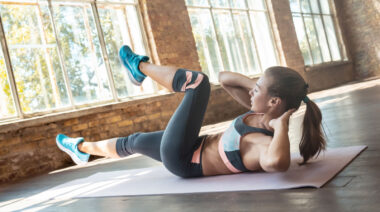One of the biggest debates in strength and hypertrophy training has always been about whether or not you can get strong and swole from bodyweight training only. Perhaps the reason this question even comes up is that for many their only understanding of bodyweight training comes from circuit classes or military PT, where high reps are the order of the day. While there are factors that influence muscle growth, such as calorie surplus and ample recovery, there are others such as tension and leverage that also come into play when trying to maximize strength and size.
Today we’re going to look at a few of the easiest ways to add difficulty to your bodyweight training in order to maximize strength and size. Who knows, you may even find that you can replace a majority of your resistance training simply by adopting a few of these principles and using bodyweight exercises. The great advantage is that your training can then be done anywhere, anytime, allowing you to have a far more flexible schedule.
Time Under Tension
The first principle I want you to use is an age-old trick for hypertrophy training – increasing time under tension. There is actually some science to this for those who are interested. Once a muscle contracts beyond 50%, blood flow is occluded, meaning that waste products build up within the muscle. Higher levels of lactate form, which in turn pushes growth hormone production up.
To take advantage of this method Convict Conditioning author Paul Wade suggests taking a full five seconds to perform every rep of an exercise. Do this by lowering to a two count, pausing at the bottom position for a full second, and then slowly raising yourself back to the start for another two count. Taking out the momentum and bouncing from the movement is a great way to develop control and end range strength too.
You can use a step system for exercises that need reps to track progress. For example, let’s say you begin with a 1-1-1 tempo, that is a second to lower, a one second pause, and then a second to ascend. The next step would be to go to Paul Wade’s suggestion and go for 2-1-2. From there I would suggest increasing time on the concentric. In Engineering the Alpha, by John Romaniello, he notes that a slow concentric leads to higher levels of lactate formation. So a tempo of 2-1-5 would be ideal to create high levels of hormone production as well as tension, which is necessary for high levels of strength.
Foundation One creator Coach Sommer takes this a step further by reducing rest periods between exercises. He advocates performing the main exercise then immediately going to the subsequent mobility exercise, before again immediately going back to the main exercise until all sets are done. Limiting rest periods is another way to drive up lactate and growth hormone production and when combined with slowing down our movement speed packs a solid one-two punch to help with boosting muscle size.
Leverage
One of the biggest roadblocks for people when looking to gain strength and size with body weight is that they lack imagination. For many they get to a point where they can do ten push-ups, or twenty or more, but at that point, unless they start to slow down their training like I mentioned above, their progress will halt. At that point it’s necessary to start playing around with leverage. Using push-ups as an example, you can make them harder by placing your feet on a box behind you so that you’re on an incline. Taken a few steps further, if we keep elevating the feet you’ll end up in a handstand where push-ups are far harder.
Asymmetry
We can also use leverage to our advantage by doing exercises asymmetrically. Using push-ups again as our example, you could go straight to one-arm push-ups. There’s no denying that the level of total body strength needed for one-arm push-ups is well beyond that needed for regular push-ups, but what if you can’t jump straight from regular push-ups to one-armed?
We can begin working on asymmetry by doing an archer push-up. The start position is just like a regular push-up except that your hands will be much wider than usual – well outside shoulder width. The difference being that instead of dropping down evenly between your hands you will slide your weight over all the way to one hand. The other hand will end up out stretched so that in the bottom position you look like an archer pulling back a bowstring. As you come up you’ll return to top center and then drop to the other side. While still challenging these are a good step between full one-arm push-ups and regular push-ups. This same technique can also be used for both pull-ups and squats as you transition from bilateral work to unilateral.
One caveat: in bilateral exercises you start to work asymmetrically to add difficulty, but when you are working one-arm variations you need to change your leverage to make them harder. For example, in one-arm push-ups you’ll probably start with your feet wider apart for stability, but as you get stronger you’ll need to start getting your feet closer together. This change in leverage will make things far more challenging. I’ve yet to see someone do a rock solid snake push up – that is a feet-together, one-arm push-up.
So take those three concepts and play around with them, as there is enough mileage there to give you a few years worth of training if you are diligent. Don’t be surprised if you wind up far stronger than you are now with a body that is supple yet resilient. Personally, nearly all of my hard strength work is bodyweight at the moment and my body feels the best it has in a few years.






